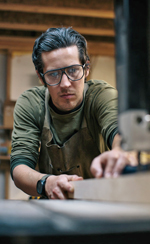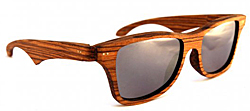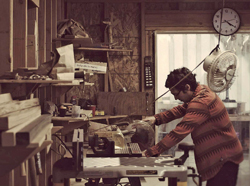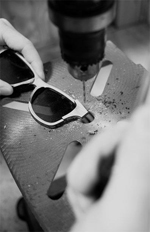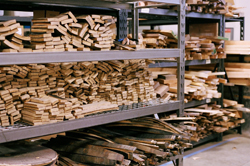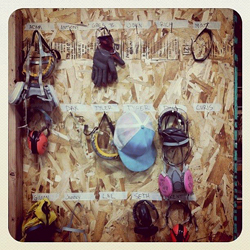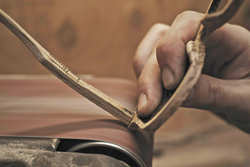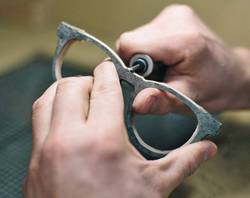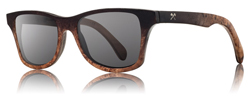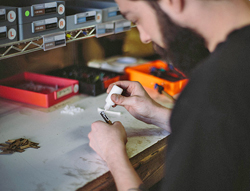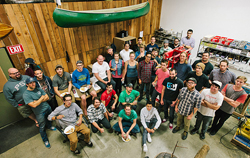
On display among the glitz and glamour of New York’s Fashion Week this past fall was a small collection of trendy new sunglasses. That’s not surprising, of course, until you learn that the frames were all handmade of wood. More specifically, it was the same woods that are being used for the dashboards of Mercedes-Benz’s new 2014 S-class sedans.
The source of those sunglasses is a small manufacturing company called Shwood, located in the Portland, Oregon, area. It’s about as far away from the fashion runway as you can get. And company founder Eric Singer, a 20-something woodworker and snowboarder, has only been making these signature sunglasses for about eight years. But what started as a pair he carved from the branch of a neighbor’s madrone tree has blossomed into a company of more than 40 employees who now can make up to 300 pairs of custom wooden frames a day.
Mercedes contacted Shwood just two weeks before Fashion Week, wanting to partner up as the event’s official sunglasses sponsors, Eric says. “I didn’t have to think about it for long, even though that was a crazy short amount of time for us create those frames. We had no idea what all would be involved from Mercedes’s standpoint. I just said, ‘Hell yeah!'”
Turn back time to 2005, and Eric was fresh out of high school with an interest in woodworking but no clear idea about what he wanted to do with his life next. He was making end tables and other furniture as a hobby, when he wasn’t snowboarding or working part-time at a movie theater. Furniture was fun, but it wasn’t a moneymaking venture. “I’ve always been a creative kind of guy, with painting, sculpture or drawing … and my dad was a good woodworker. I’m sure I was crawling around in his sawdust as a little kid,” Singer says.
Then, the inspiration hit. Not sunglasses per se, but the urge to chop down a branch of his neighbor’s backyard tree and do something “woodworking” with it. “Madrone trees are native to the Pacific Northwest, and their bark turns this beautiful shiny orange color every year,” Eric says. “That wood just captivated me.”
So, by dark of night, he jumped the fence, sawed off a limb and, after pondering over what to do with it for awhile, decided to carve it into a pair of sunglasses. He already collected old sunglasses, so making a pair from wood just seemed a natural choice. He popped the lenses out of a pair, ground down some tiny hinges and cobbled together his first custom eyewear.
Eric made those first pair of shades in two days, and they were bulky to wear, he admits. But he wore them to a local skatepark, and the locals thought they were pretty cool. “Before I knew it, I was making sunglasses for $20 a pair. It wasn’t a business, that’s for sure. It was just something new to make … I was bored with furniture, and this was fun.”
It took a couple of years to improve his processes using ordinary woodworking tools, but Eric says that every pair he made got a little bit better. He bought both his lumber and tools from Rockler’s Portland-area store, and he used money made from the movie theater job to invest in more tools. Then, one winter Singer decided to move to the ski slopes around Bend, Oregon, and live out of his 1978 Honda Civic for the snowboarding season. During that time, he made sunglasses from tools he carried in the car, and he continued to sell them to friends and family.
Snowboarding that season opened doors of new possibility. Around 2008, Eric met a couple of friends who ran a traveling snowboarding show called Campus Rail Jam. Singer decided to go on tour with them for a year, traveling the college campus circuit to do snowboarding events as well as making sunglasses.
More connections during that time solidified, and four close snowboarding buddies, Taylor, Ryan, Dan and Phil, urged him to take the sunglasses hobby more seriously. Eventually, the five friends decided to form a partnership and call the business “Shwood.” The name was actually an inside joke: a friend once needed a formal sponsor in order to enter a snowboarding competition, and his fictitious sponsor “Shwood” was coined from the name of a cheap motel called Ashwood. The “A” in the motel’s sign was burned out. Among about ten different possible options for product names, Shwood stuck with Eric.
Among the Shwood partnership, Taylor had experience with marketing and web design. Phil was the merchandiser. Ryan and Dan were the company’s first sales force. The five buddies pooled their financial resources and founded Shwood Eyewear formally in October 2009. “We’ve never had outside financial help,” Singer says, “and I had absolutely no idea how to run a business. I’m lucky these are such great guys, because they have been instrumental in making this whole thing work!”
Even though the business was underway, the first “Shwoodshop” was modest: a 7 x 15-ft. workspace next door to a cabinet shop. Eric was its only builder, making just five pairs a day while the partners took care of other aspects of the new business from an office across the street.
Singer, who admits to having no formal training as a woodworker, had to teach himself resawing techniques in order to cut the thin veneers that make up each frame. The company eventually bought a secondhand laser cutter, which made precision cutouts for the frames and bows much more quickly and accurately, as well as a used 16-in. band saw and a dual-spindle drum sander.
The hours were long and hard, Eric admits, “and after I had made the first 25 pairs of Shwood glasses, I thought, ‘This is cool — I’m actually building inventory!'”
But the scope of things wouldn’t stay small for long. When Taylor launched the company website, it was welcomed with a quick and unexpectedly brisk response: two days later, a blogger posted about Shwood, “and orders started flying in,” Eric recalls. “Before we knew it, we had 200 orders and backorders for months … none of us knows for sure how we didn’t fail back then. We were flying by the seats of our pants.”
As soon as it was feasible, Shwood began to hire shop staff and moved into a bigger 30 x 50-ft. shop space. As the steady flow of orders increased, lumber quantities changed from a few boards at a time to truckloads. Even since those early days, Singer says the company has always been committed to buying lumber from sources that harvest it sustainably from plantations. Several of the mainstream domestic species also come from sawmills in the Portland area.
In 2010, Shwood expanded and moved to its current 6,000-square-foot facility where it produces 130 different sunglass options. Most of the production process is still done in-house and by hand, including sanding. Eric won’t reveal some of the proprietary secrets, but he says there are between 30 and 35 steps involved in cutting, shaping, laminating and finishing the frames, plus cutting and grinding the Carl Zeiss lenses that are fitted to each pair. In an effort to keep product as natural and environmentally friendly as possible, Shwood uses water-based glue in the lamination process and shellac as the final finish. This year, Shwood launched a new line of frames made of stone, and he hints that the company will explore other natural materials besides wood going forward “in order to stay relevant and fresh.”
But Singer is sure Shwood Eyewear will always stay close to its wood-framed roots. Zebrawood frames continue to be best sellers, and European walnut is his favorite, because the company has found a way to ebonize it to classic black color. Maple, cherry and various burls are also used.
When asked why wood is an appealing medium for sunglasses frames, Eric offers two trains of thought. “I had never seen it done before, and uniqueness has always been part of who I am … but also, wood has a warmth to it, and the frames sort of mold to your face, unlike other sunglass frames. Wood is in the moment and ‘real’, sort of like life. Sunglasses gives you a different kind of intimacy with something that was living.”
Whether it’s a trendy fashion statement these days or because of the organic appeal, the popularity of Shwood eyewear continues to grow both with consumers and as a result of connections with other leading product brands. Singer marks several milestones in the company’s short history: Shwood has recently partnered with Pendleton Woolen Mills and Bushmills Irish Whiskey to make limited-run custom frames. And, of course, there’s the recent brush with Mercedes-Benz.
“Being approached by heritage brands like these, and being relevant in the fashion world just confirms to us that we’re doing things the right way, Eric says. “I could never have afforded these brands growing up, and now they’re coming to us.”
The notoriety is also helping sales. Eric says that in 2009, Shwood sunglasses could be had for about $95 a pair. Now, prices range from $145 to $325, depending on style and wood choice. But even as the cost of a pair of handmade sunglasses goes up, “the quality of our product is how it sells itself. Sales has never been the hard part.”
He’s also proud of a special small business honor bestowed on Shwood by Dell computers and MasterCard in 2011. The company entered a national video contest in the hopes of winning “America’s Favorite Small Business” honors. In a people’s choice vote, Shwood Eyewear was awarded first place among 20 top finalists. A six-part reality-style “webisode” was created by Dell to share more about Shwood, and you can watch them by clicking here.
It’s undoubtedly been a whirlwind adventure for Singer, who less than 10 years ago was wondering what life would bring next. But, when reflecting on where he’s come from and where Shwood Eyewear may take him in the future, his answer is honest and unfiltered.
“Nothing I had ever done before this really took off … If I hadn’t taken the leap and lived a bum life as a snowboarder for a while, I never would have met my partners. If anything, it’s taught me that in life, sometimes you’ve just gotta take risks.”
